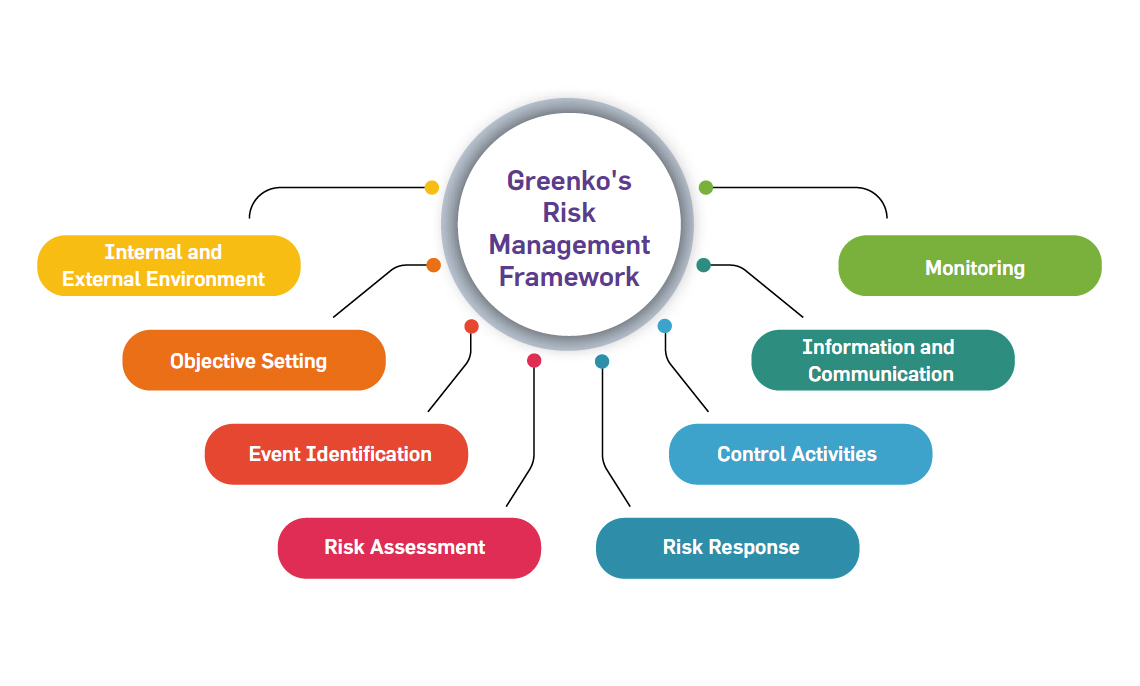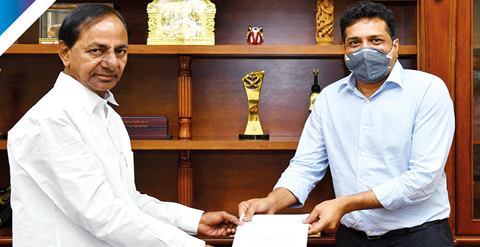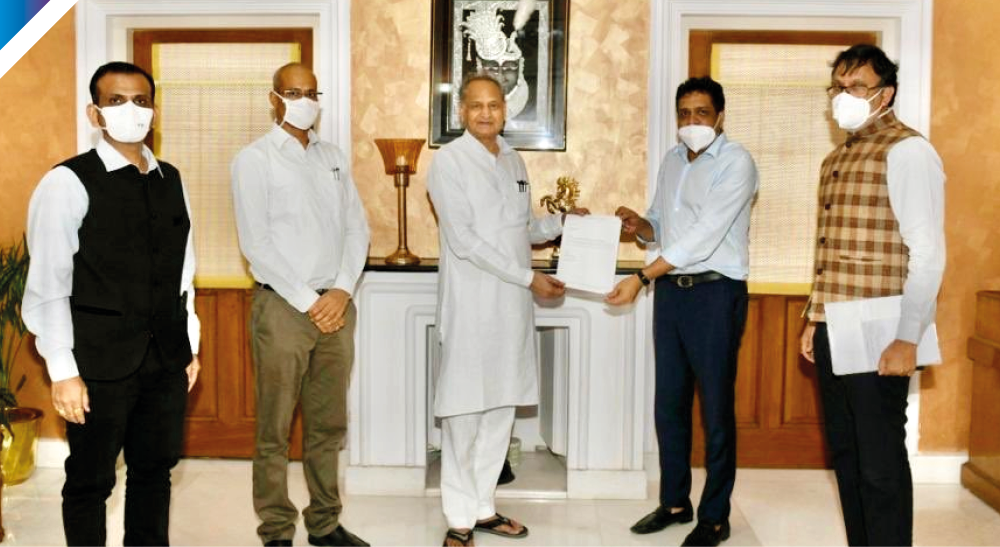Greenko Risk Management Framework (GRMF) is developed based on the Committee of Sponsoring Organizations of the Treadway Commission (COSO) and some elements of Operationally Critical Threat, Asset, and Vulnerability Evaluation (OCTAVE) are also adapted. The Board and the Audit Committee approve the company’s risk control and management. They review internal control systems regularly to ensure that the main risks are properly identified, managed, and disclosed.
Under GRMF, the Board and management assesses and monitors risk from a high-level, or portfolio view. This allows management to first identify risks and then analyze the enterprisewide effects of these risks.
The GRMF is geared to achieve the following objectives.
Managing risks in these four categories within an entity’s risk appetite will aid in the creation of stakeholder value.
Members of top management play a critical role in GRMF. Currently, the GRMF is jointly handled by Risk, Legal and Compliance functions. When management considers alternate ways to achieve its strategic objectives through different strategic choices, it uses GRMF to evaluate risks associated with each alternative. In the instance of IRESP, prior to finalizing the size, scale, location, and timing, the management has determined that their strategy is within their overall risk appetite. Focusing on strategic objectives and strategy allows Greenko to develop related objectives at the business level. Business-level objectives are linked to and integrated with more specific objectives (i.e. operations, reporting, and compliance). These specific objectives are broken down further into sub-objectives established for various activities, such as GAM, Commercial, Projects, Procurement, and other functions.

 As we continue to strengthen our core team and initiate value addition
to various business functions, we acknowledge that our corporate
-legal function does not merely comprise of litigation remediation but
spreading awareness across the organization by being proactive to
identify and set a roadmap.
As we continue to strengthen our core team and initiate value addition
to various business functions, we acknowledge that our corporate
-legal function does not merely comprise of litigation remediation but
spreading awareness across the organization by being proactive to
identify and set a roadmap.

General Counsel
The Greenko Risk Management Framework consists of eight components:
Risk Management Organization Structure

This entails to proactively and systematically identifying and analysing potential climate-related hazards to Greenko’s operations based on projections of climate change models. The integration of climate risk assessment in the existing framework was carried out by identifying the physical and transition risks of climate change that have the potential to profoundly impact Greenko’s business. Presently the climate risk assessment is conducted for six of its critical operating sites.
Greenko’s Climate Risk Management Strategy
The Board desired for the management to consider assessing the climate risk and if found significant and appropriate include the same in the GRMF. Further, the Board reinforced Greenko’s commitment to UNSDG’s, especially SDG-7 (affordable and clean energy) and SDG-13 (climate action). The management undertook the climate risk assessment accordingly during 2020.
In 2020, Greenko analysed the impacts of different climate scenarios for transition and physical risks which included the scenario in which the Government of India will enact to accelerate the renewable energy adoption as also physical changes occur as per Global Climate Change scenario RC 4.5. This analysis confirmed that the group’s business model is adequate to face the challenges arising from climate change. However, the analyses also have resulted in additional operational steps at each site as also additional criteria while evaluating new assets and technology choices.
In the case of physical impacts derived from the main climatic threats and the increase in the frequency and severity of extreme weather events —, Greenko has plans and systems to improve the resilience of all assets and components. Also, we have begun discussions with the insurance institutions to cover climate risk resulting in extreme weather events.
The GRMF considers and monitors the risks derived from climate change:
Greenko does not foresee that these risks will have a catastrophic or permanent impact on the assets and revenues. This is also because of the portfolio of assets and their spread across the geography. However, the group anticipates a marginal increase in operational expenses. In addition, the opportunities that the company derives from the decarbonization of the energy system in India.
Climate Risk Mitigation
Mitigating climate risk is a continuous process and Greenko’s Risk Assessment and Management Framework enables to build resilience against variations in climate by taking account of all the potential climate risks in its operations and planning appropriate mitigation strategies.
As part of its climate risk management strategy, Greenko has adopted an effective climate risk mitigation strategy, one element of which includes upgradation of existing Early Warning System (EWS). The existing Early Warning System of Greenko, has now incorporated the monitoring and warning of global warming induced extreme events (acute risks), whose frequency and severity are projected to increase as a result of climate change, to proactively protect and minimize the impacts of climate change on its assets and the community it operates in. The purpose of the EWS strategy is not just limited to planning and executing risk-mitigating measures but to build resilience. The EWS mainly functions based on the synergy between visual observations, past experiences, and co-operation to mitigate losses from upcoming hazards.
This can lead to a significant loss of revenue and higher costs, ultimately resulting in decrease of overall profitability. Businesses like Greenko, is dependent on nature and various factors such as people, infrastructure, location, technology etc. for a major part of their activity and are more prone to threats & disruptions due to external environment. Greenko understands that the business is prone to numerous disasters varying in their degree, from minor to catastrophic and including those occurring because of climate change. BCP is a process that an organization undergoes to create a prevention and recovery system from potential threats, such as natural disasters or cyber-attacks. Greenko’s BCP is designed to protect personnel and assets, and make sure they can recover and function quickly when any such disaster strikes.
The business impact analysis at Greenko, is a critical function. This function is guided by the Business Continuity Steering Committee (BCSC), which comprises of senior management and key stakeholders to ensure visibility. Business Impact Analysis (BIA) is conducted for each department/function at Greenko. Any department, which if non-functional for few days leads to hampering of the business, is termed ‘critical’. These departments/functions are considered first in-line for the implementation of a Business Continuity Plan. These departments/functions can either be from the corporate side or site specific. All departments and branches at Greenko are BCP compliant. Internal and external audits are being conducted on a regular basis to verify the effectiveness of implementation of BCP. BCP testing of the sites is done twice a year, For Information Technology (IT), testing is also conducted twice year. For critical functions testing is conducted every six months. Greenko is committed to provide a safe and healthy work environment. This is achieved by preventing accidents and occupation related ill-health and assessing risks related to sites and overall work culture safety preparedness. Employees are communicated, instructed, and trained on emergency preparedness and Business Continuity. Greenko has a comprehensive Disaster Recovery Plan which comprises of a Locational recovery plan, Data centre recovery plan, DR site and technology related challenges. BCP mock drills are an important function ensure preparedness in case of emergencies / exigencies and are an important part of the larger Business Continuity Management Plan.
The group also has a Crisis Management Plan to address large natural disasters, cyber-security threats etc.
 COVID-19_Telangana CM Relief Fund
COVID-19_Telangana CM Relief Fund
 COVID-19_AP CM Relief Fund
COVID-19_AP CM Relief Fund
 COVID-19_Rajasthan CM Relief Fund
COVID-19_Rajasthan CM Relief Fund
Business Continuity during COVID Times
During this unprecedented situation of COVID - 19 Pandemic, Greenko has given top priority to its Employees’ Health & Safety. They have initiated special risk mitigation measures for prevention & spread of contiguous disease, this is being practiced by educating employees over New norms of Social distancing, Hygiene practices, Screening of employees & stakeholders and focus on disinfection and online health monitoring of employees, carried out from time to time.
Greenko has also imparted training over work resumption post lockdown to all employees in its business, Viz. 5260 Employees in a span of a week to cope with new requirements.
During the initial period of COVID – 19 spread in other countries and declaration of global emergency by WHO, the group had anticipated a huge crisis with respect to employee engagement, plant & office operations. The senior management quickly planned and implemented decisions to manage operations by keeping 50% employee strength at work and enabling the rest to work from home. They could login, on need basis for necessary support, to ensure uninterrupted power supply to the stakeholders. Since the initial phase, this global crisis was addressed and various operational, health & safety challenges were readily handled. The timely action proved to be a blessing in disguise to keep the employees safe and run the business operations smoothly with minimum manpower & resources.
Greenko has devised a work resumption after lockdown procedure, which contains
As COVID-19 is rapidly spreading in the country & cases are sporadically popping up in the entire country and some cases were also noted in Greenko’s office campus, they have devised a COVID - 19 task force with the involvement of top management to ensure quick response over medical needs and concerns.
The Main tasks of COVID–19 taskforce include: